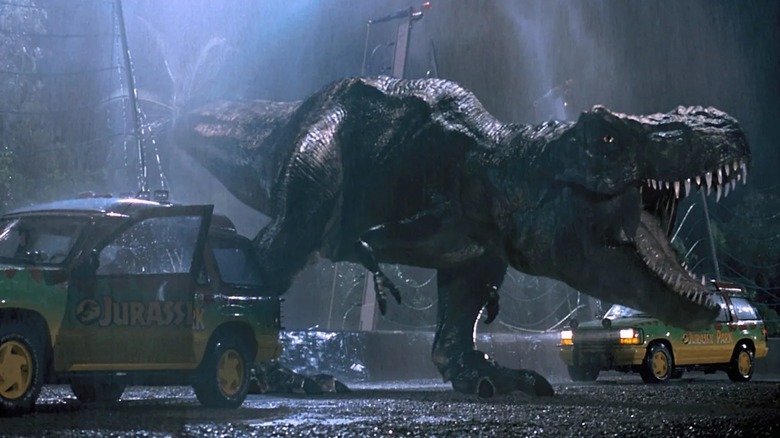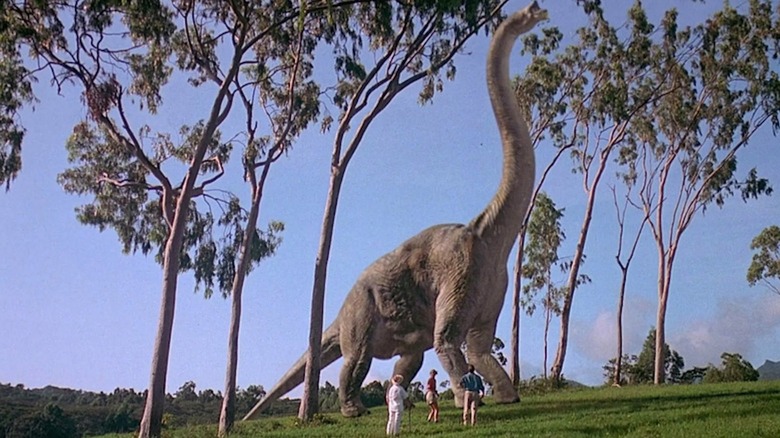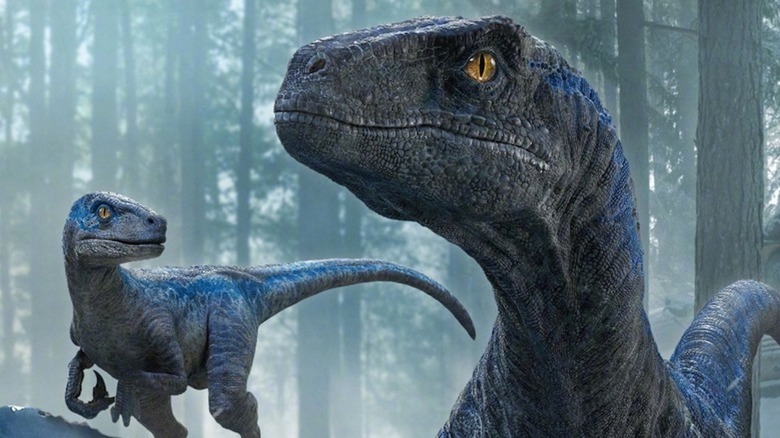Jurassic World Rebirth Is A Cry For Help From A Series That's Run Out Of Ideas
When Steven Spielberg's adaptation of Michael Crichton's bestselling sci-fi/horror novel hit theaters on June 11, 1993, the entire motion picture medium was forever changed. James Cameron had given us a tantalizing taste of how seamlessly computer-generated imagery could be integrated into a motion picture via "The Abyss" and "Terminator 2: Judgment Day," but no one was prepared for Spielberg and his visual FX team (which included Cameron collaborator Dennis Muren) to blast the technology seemingly decades into the future by creating photo-realistic dinosaurs. That moment where Sam Neill, Laura Dern, and Jeff Goldblum get their first look at a living, breathing brachiosaurus induced a new kind of awe in moviegoers, and it remains a blessing and a curse that Spielberg was the man at the helm.
The blessing is that the bar was raised so dizzyingly high for photoreal CGI that, in the immediate wake of the film's blockbuster success, many directors were too intimidated to use it. Obviously, studios wanted more of the magic, but the best studio filmmakers at the time understood the technology's limitations and realized how perfectly suited it was to a movie like "Jurassic Park." Furthermore, they got that it was a powerful new tool that could amplify the effectiveness of practical FX (like Stan Winston's stunningly tactile dinos) and vice versa. The techniques worked in tandem with each other, but they needed to be wielded by directors who knew how to stage a set piece with little to no coverage, otherwise, you'd end up with something hilariously junky like the crocodile attack in 1996's Arnold Schwarzenegger actioner "Eraser." CGI was for closers.
It didn't stay this way. By the time Spielberg got back in the saddle for 1997's "The Lost World: Jurassic Park," the awe was gone. So the man who'd hastened the future rather wisely opted to make a great big monster movie that ended with a T-rex rampaging through the streets of San Diego. The result was a mixed bag. Spielberg reminded us that he is second-to-none when it comes to staging a terrifying set piece (via the trailer attack and the velociraptors hunting the hunters in the tall grass), but it was more proficient than dazzling. When Spielberg handed the reins over to the FX-savvy Joe Johnston for 2001's "Jurassic Park III," moviegoers got a brisk, 92-minute B-movie that delivered pure Harryhausen giant monster thrills. I sincerely think it's the best "Jurassic Park" movie of them all (if only because it unabashedly exploited the series' pulp concept), but, walking out of the theater 24 years ago, I remember feeling like the entirety of my dino itch had been thoroughly scratched. I didn't need another "Jurassic Park" movie.
Universal did, but it would take the studio 14 years to figure out how to freshen up the formula. They succeeded commercially, but fell far short creatively. And now, with the disappointing "Jurassic Park Rebirth," they've run smack into a dead end.
The Jurassic World movies have been popular, but are they beloved?
Most blockbusters do not, on an artistic level, merit sequels. The studios should've learned this in the 1970s when they spun out with John Boorman's bizarro "Exorcist II: The Heretic" and John Korty's abominable "Oliver Story" (the follow-up to Arthur Hiller's "Love Story"), but these sadly became exceptions commercially. Sequels were generally safe bets for studio executives worried about job security, and a boon to marketing departments, which could sell audiences on an unnecessary movie by reminding them how much they loved the previous film.
When Colin Trevorrow's "Jurassic World" stomped into multiplexes, it was far more inevitable than necessary. But the timing was perfect: once older moviegoers heard that John Williams score, they were both desperate to re-experience the magic of Spielberg's movie, and amped to share that ecstatic feeling with their children. A decade later, it is the 10th highest-grossing film in worldwide box office history.
If you treat movies as a thing that's on in the background while you scroll your favorite apps, text your friends, and play whatever is the hot game of the moment, "Jurassic World" is a pretty good option as a spectacle-laden third or fourth screen. If, however, it's the only thing you're paying attention to for two hours and change, it's sorely lacking in just about every department save for CG.
The majority of moviegoers do not share my overall disdain for the "Jurassic World" series. Since rebranding, each of these films has made over $1 billion worldwide. It seems possible that "Jurassic World Rebirth" will fall short of that magic global number, but this may be more attributable to franchise fatigue than quality (as this deeply flawed movie still offers up a far more satisfying experience than Trevorrow's "Jurassic World: Dominion"). Then again, Edwards' movie earned a troublingly ho-hum B Cinemascore, whereas the last three installments received A or A- grades.
Should "Jurassic Park Rebirth" wind up being a commercial disappointment, Spielberg and Universal will likely scramble to course correct because, considering the myriad threats to theatrical exhibition (something Spielberg strongly believes in), you can't just let a multi-billion-dollar franchise up and die. How do we save the dinosaurs? I'm not sure that we can.
The only way to save Jurassic Park is to hit pause or take a genre-bending risk
My favorite scene in "Jurassic World Rebirth" is easily the Titanosaurus mating sequence, where Edwards comes shockingly close to evoking the awe we all felt during the brachiosaurus introduction in "Jurassic Park." These majestic creatures, conjured out of 1s and 0s, can still touch the six-year-old in all of us.
It would be lovely and more than a little reassuring in our age of appalling cruelty to think that a blockbuster could prioritize joy over fear, but I think moviegoers are hardwired to expect armrest-clutching set pieces from the "Jurassic Park" franchise. Fair enough. But you're still chasing a high that can't be recaptured. Nothing will ever top that first T-rex attack, in part because no one can out-Spielberg in this thrill-producing department, but also because the blend of practical and CG that made that sequence sing is almost impossible to replicate today. This kind of physical scale and artistry is anathema in today's Hollywood. (Indeed, there are no practical dinosaurs in "Jurassic Park Rebirth.")
Cynically, the solution may be to bring Chris Pratt, Bryce Dallas Howard, and Blue the Raptor back for another adventure. This wouldn't move the needle for me, but it could appease younger moviegoers. The series has already brought back the stars from the original trilogy, so there's nothing to be gained there.
Universal's smartest move is one they probably don't want to make, which would be to mothball the franchise for a decade and let the generation that came of age on the "Jurassic World" movies build up their own nostalgia for this series. I'd love to see them think outside the box and do something as wild as John Sayles proposed with his "Jurassic Park IV" screenplay, which featured dinosaur-human hybrids. This would take the series back to the B-movie giddiness of "Jurassic Park III," but infuse it with the mad-scientist horror of something like H.G. Wells' "The Island of Lost Souls." As this is unlikely to happen, I think Universal is currently on the same track of diminishing returns that, 77 years ago, found them trying to wring a little more profit out of their fading Classic Monsters franchises by teaming them up with the comedy duo of Abbott and Costello.
In other words, the only logical way forward for "Jurassic Park" is to introduce the dinos to the dynamite pair of Keke Palmer and SZA, who just scored a surprise box office hit with "Just One of Them Days." Give these gals gigs at InGen, and savor the chaos. Otherwise, close down the damn lab and give the dinosaurs a much-needed rest.


